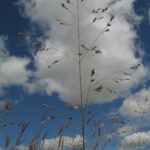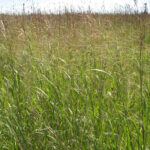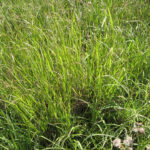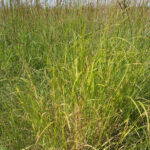Switchgrass
Panicum virgatum
General Description
Switchgrass is a native warm season perennial grass. Forage production is notably high for this species due to its height and leaf production. The upland type with more bunch-like characteristics and shorter rhizomes is more common in Canada than the lowland types which are highly rhizomatous. Switchgrass grows from 60 to 150 cm (2 to 5 ft) tall. It has stiff stems that support numerous leaves and abundant seeds. A white patch of hair can be found where the leaf attaches to the stem. Leaves are 10 to 50 cm (4 to 20 in) long and to 1 cm (0.4 in) wide. The leaves are generally long and flat, green, becoming golden into the fall. Switch grass seed heads are large spreading, branched panicles atop stems. An abundance of clean, small to medium-sized seeds are produced yearly. Short rhizomes help spread the plant vegetatively.
Switchgrass is suitable for grazing, hay or silage. Switchgrass can produce relatively good yields in the 2,100–2,700 corn heat units (CHU) areas and will perform better in longer-season regions.
Type
Native grass.
Origin
Native to eastern Mixed Grass Prairie and Tall Grass Prairie of Saskatchewan and Manitoba. Cultivars have been developed.
Longevity
At least 10 years (seeded). Can be long-lived in native stands.
Use
Reclamation, pasture. Historically, switchgrass was used for hay, but poor palatability at maturity makes it less suitable. Switchgrass has been tried in some areas of Canada and the United States as a biofuel.
Optimal Time of Use
Summer. Switchgrass is a warm season grass and does not begin growing until early summer. It becomes coarse quickly as it matures. Switch grass has the ability to produce a large quantity of forage.
Recovery After Use
Requires a minimum 60-80 days of recovery after use. It grows rapidly once its growth is initiated. Leave at least eight inches (200 mm) of plant growth after grazing to enhance winter hardiness.
It grows rapidly once its growth is initiated. Leave at least eight inches (200 mm) of plant growth after grazing to enhance winter hardiness.
Palatability/Nutritional Value
Switchgrass becomes unpalatable after maturity. As seed heads emerge, palatability decreases. While crude protein is good early in the summer (up to 15%) it can drop to less than 4% by later summer/early fall. When old, stiff stems accumulate they will have lower quality and will actually deter livestock use. Switchgrass tends to have low crude protein and digestibility, and animal rates of gain and intake are modest.
Annual Precipitation min/max (mm)
305mm / 1525mm
Drought Tolerance
Low tolerance.
Flooding Tolerance
Switchgrass can withstand up to 5 weeks of flooding in spring.
Winter Hardiness
Fair hardiness. Native upland types are most hardy compared to lowland types for the Canadian climate.
Soil Texture Preference
Switch grass is adapted to loam soils (sandy-loam through clay-loam). In Canadian climate, moist, but well drained soils are preferred. Switchgrass is frequently found in moist areas in native stands.
Erosion Control
Moderate ability to control erosion. Produces short rhizomes and good above ground cover. Switchgrass was used widely for erosion control and wildlife habitat across the United States and Canada in the 1990’s.
Salinity Tolerance
Moderate tolerance.
Acidity Tolerance
Low tolerance.
Alkalinity Tolerance
Moderate tolerance.
Seeds per kg
858,000 seeds/kg (389,000 seeds/lb)
Suggested Mixtures
Plant with adapted warm and cool season native species for reclamation and grazing. Successful if seeded by itself.
Ease of Establishment
Switchgrass establishment has not been experimented with in plot trials in the eastern Prairies. Ducks Unlimited Canada has included it in many of their native habitat plantings. American sources state switchgrass seedlings have low vigor as they grow from small seeds and have mixed ability to root quickly. Good weed control is needed for establishment as cool season weed species can easily outcompete the switchgrass (warm season grass). Some self-seeding and spread by short rhizomes can occur.
Good site preparation is key for establishing a successful switchgrass field. Field preparation should typically include one or two secondary tillage passes followed by packing or cultipacking. Packing the soil before and after planting is highly recommended on all soil types. American sources state switchgrass seedlings have low vigor as they grow from small seeds and have mixed ability to root quickly. Good weed control is needed for establishment as cool season weed species can easily outcompete the switchgrass (warm season grass). Some self-seeding and spread by short rhizomes can occur.
Competitiveness
Switchgrass is not a strong competitor in the first few years but becomes more competitive as the stand ages. Cool season grasses are at peak production when switchgrass begins to grow.
Management Considerations
Switchgrass is particularly sensitive to improper management. Rotational grazing systems that allow for plenty of rest between grazing periods have demonstrated that native switchgrass (among other native warm season species) can become more abundant in a stand that had seemingly lost the species. Early-summer grazing or mowing of cool-season species in the mixture is likely to give this warm-season grass the opportunity to co-exist with aggressive cool-season grasses. Switchgrass initiates growth later in the season than cool season grasses so allow for adequate plant growth before grazing (at least 12 inches tall), but before seed heads develop in August. Switchgrass responds positively to fertilization.
Manitoba Forage Adaptation and Comparison Guide, USDA Plants Database, Switchgrass Agronomy 2016 (Ontario), Grasses of Saskatchewan, AAFC data unpublished, Publication 30-OMAFRA



